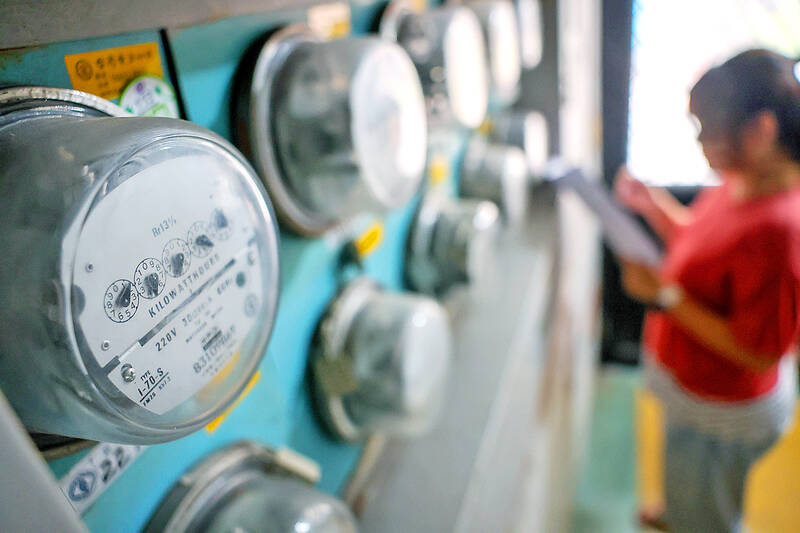Taiwan Power Co (Taipower, 台電) is to hike electricity rates by 12.5 percent on average for industrial users to reflect fuel cost surges, while leaving tariffs unchanged for households and food retailers like convenience store operators to help stabilize living costs, the Ministry of Economic Affairs said yesterday.
The ministry announced the new electricity price scheme after an energy price review committee wrapped up its biannual meeting.
That marked the fourth price increase in three years for industrial users.

Photo: CNA
The state-run utility has to rationalize its power tariffs gradually to support its grid construction projects to boost power supply, the ministry told a media briefing yesterday.
Based on the new price scheme, industrial users would see their electricity bill increase by up to 14 percent if they consume more power this year than last year, Taipower said.
Semiconductor companies fall under this category, the company said.
Electricity rates for industrial users whose power consumption drops by at least 5 percent and revenue dips by at least 15 percent year-on-year would remain unchanged to ease their financial burden, Taipower said.
Scooter and component makers fall under this category, it said.
Some industrial users would see less steep price hikes of about 7 percent, if their power consumption falls by at least 5 percent and their revenue drops by less than 15 percent, Taipower said.
After the price adjustments, industrial electricity rates would climb to NT$4.29 per (US$0.1355) unit on average, which is still lower compared with that of South Korea at NT$4.65 per unit in the first half of this year.
Local exporters would remain competitive in terms of power costs, the ministry said.
That is quite different from Taipower’s past mechanism when industrial users that are heavy power users faced more drastic hikes. Now, power conservation seems to play a bigger role in deciding price increases.
The new electricity tariffs are to take effect from Oct. 16 when the summer power rates expire.
The latest price increases would inject NT$15 billion in additional revenue for Taipower in the remainder of the year, while it would add 0.03 percentage points to the nation’s inflation indirectly this year, Taipower vice president and spokesman Tsai Chih-meng (蔡志孟) said.
Taipower expects the price hikes to help narrow its losses to about NT$80 billion per month, as it is still making losses from supplying power to households, Taipower president Wang Yao-ting (王耀庭) told a media briefing.
Electricity tariffs for households stand at NT$2.77 per unit on average, significantly below Taipower’s costs of NT$3.9 per unit, the company said.
Taipower would still need the government’s subsidy and the legislature’s support to absorb accumulated heavy losses of NT$400 billion, Wang said.
The Cabinet has budgeted NT$100 billion in subsidies each for this year and next year, which are still subject to the legislature’s approval.

A car bomb killed a senior Russian general in southern Moscow yesterday morning, the latest high-profile army figure to be blown up in a blast that came just hours after Russian and Ukrainian delegates held separate talks in Miami on a plan to end the war. Kyiv has not commented on the incident, but Russian investigators said they were probing whether the blast was “linked” to “Ukrainian special forces.” The attack was similar to other assassinations of generals and pro-war figures that have either been claimed, or are widely believed to have been orchestrated, by Ukraine. Russian Lieutenant General Fanil Sarvarov, 56, head

SAFETY FIRST: Double the number of police were deployed at the Taipei Marathon, while other cities released plans to bolster public event safety Authorities across Taiwan have stepped up security measures ahead of Christmas and New Year events, following a knife and smoke bomb attack in Taipei on Friday that left four people dead and 11 injured. In a bid to prevent potential copycat incidents, police deployments have been expanded for large gatherings, transport hubs, and other crowded public spaces, according to official statements from police and city authorities. Taipei Mayor Chiang Wan-an (蔣萬安) said the city has “comprehensively raised security readiness” in crowded areas, increased police deployments with armed officers, and intensified patrols during weekends and nighttime hours. For large-scale events, security checkpoints and explosives

‘POLITICAL GAME’: DPP lawmakers said the motion would not meet the legislative threshold needed, and accused the KMT and the TPP of trivializing the Constitution The Legislative Yuan yesterday approved a motion to initiate impeachment proceedings against President William Lai (賴清德), saying he had undermined Taiwan’s constitutional order and democracy. The motion was approved 61-50 by lawmakers from the main opposition Chinese Nationalist Party (KMT) and the smaller Taiwan People’s Party (TPP), who together hold a legislative majority. Under the motion, a roll call vote for impeachment would be held on May 19 next year, after various hearings are held and Lai is given the chance to defend himself. The move came after Lai on Monday last week did not promulgate an amendment passed by the legislature that

A magnitude 7.0 earthquake struck off Yilan at 11:05pm yesterday, the Central Weather Administration (CWA) said. The epicenter was located at sea, about 32.3km east of Yilan County Hall, at a depth of 72.8km, CWA data showed There were no immediate reports of damage. The intensity of the quake, which gauges the actual effect of a seismic event, measured 4 in Yilan County area on Taiwan’s seven-tier intensity scale, the data showed. It measured 4 in other parts of eastern, northern and central Taiwan as well as Tainan, and 3 in Kaohsiung and Pingtung County, and 2 in Lienchiang and Penghu counties and 1